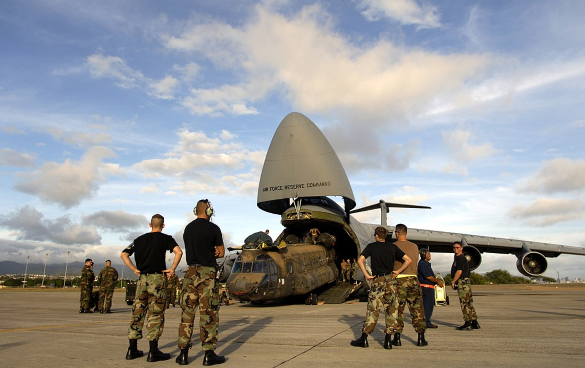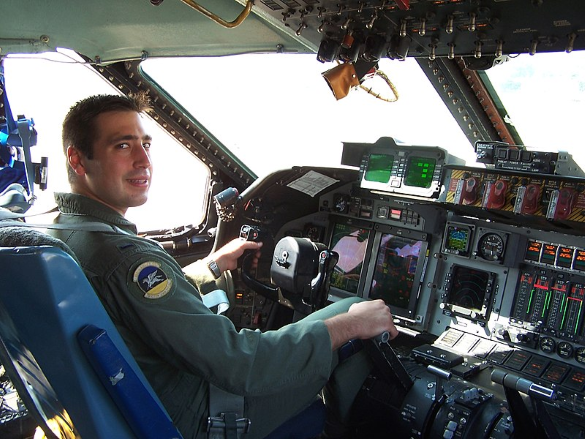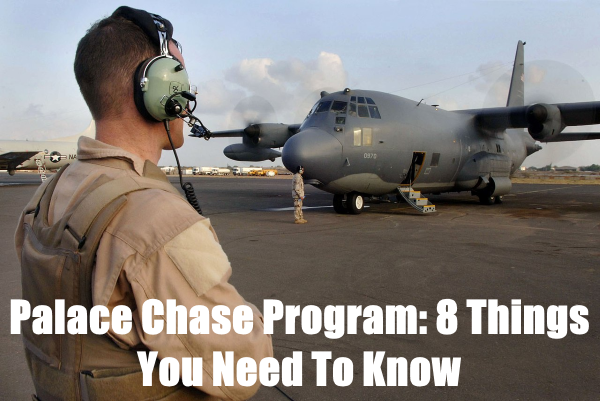When people join the Air Force, as officers or enlisted members, they make a commitment to serve on active duty for a certain number of years.
Though some may decide to continue their active duty service up to and beyond their initial commitment, others may wish to transition to an Air Reserve Component.
The Palace Chase program allows for this transition from full-time active service members to guardsmen and reservists that serve one weekend per month and two weeks per year.
Here are 8 things you need to know about the Air Force’s Palace Chase program.
Related Article – Air Force Reserve Benefits
Table of Contents
1. What Is The Palace Chase Program?

The Palace Chase program allows eligible Air Force personnel, both officer and enlisted, to request an honorable, early release from active duty service.
This is possible once they have served a specified percentage of their initial service commitment.
In addition, approval for the Palace Chase program is partly dependent on whether the applicant’s particular job or career field is under-manned or not.
Those who are approved for the program can then transfer to a reserve component in either the Air Force Reserves or Air National Guard.
Palace Chase gives qualified active duty members the opportunity to convert the remaining portion of their active service commitment to a reserve commitment.
As a result, Air Force members can maintain their connection with the military on a part-time basis rather than continuing their full-time active duty commitment.
The new reserve commitment is calculated based on whether you are enlisted or an officer in the Air Force, in addition to the amount of time you have left for your initial service commitment.
2. Why Is Palace Chase An Option?
The Air Force offers the Palace Chase program as an option for active duty personnel whose circumstances may have changed after joining the military.
It can also be a viable choice for those that find their full-time active service is not a good fit.
Palace Chase is a beneficial option that still allows service members to continue serving part-time as Reserve or Guard members.
This program is designed to support Air Force personnel who wish to leave active duty early or who want a path of direct transition to reserve status once a certain percentage of their service contract is met.
In this way, members can maintain their military service and benefits but potentially have more time for family life, education, and/or the pursuit of a different career.
The Palace Chase program is unique as a flexible alternative to continue serving in the Air Force with reserve status if active duty is not a viable or ideal option.
Of course, applicants must meet eligibility criteria to be considered for Palace Chase and have their application approved by a board.
Related Article – Air Force Age Limits
3. Who Can Apply For The Palace Chase Program?

Both enlisted members and officers can apply for the Palace Chase program if they meet the proper criteria.
Enlisted service members can apply if:
- they are nearing the halfway point of their first enlistment
- they are anywhere within a subsequent enlistment (under the Palace Front program)
Officers can apply if they are at or past the two-thirds point of their time-in-service commitment.
If an enlisted member is accepted into the Palace Chase program, their enlistment term with the guard or reserve is dependent on the time left for fulfilling their initial active duty contract.
For officers accepted into the program, the remaining time on their service contract is tripled and that time is served in a reserve component.
Related Article – Future Soldier Program Complete Guide
4. What Are The Eligibility Requirements For Palace Chase?
The eligibility requirements for Palace Chase include:
- Enlisted personnel: half of the initial enlistment served
- Officer personnel: two-thirds of the initial total active duty service commitment served
- Medically qualified for worldwide deployment
- Fitness standards met without exemptions or medical profile
- Valid security clearance
- Possession of (at minimum) 3 skill level in primary AFSC
Airmen and officers will be disqualified for Palace Chase under the following conditions:
- They have been notified of a PCS assignment
- They are in formal training
- Involuntary separation is pending
- They have received a 2 or referral EPR on any of their 3 most recent EPRs
- They have received a referral OPR
- Listed on a control roster
- Court martial conviction
- Court martial trial pending
- Restrictions on assignments, fitness, or deployment
It’s important that both enlisted and officer members of the Air Force understand what makes them eligible and/or ineligible for the Palace Chase program before entering into the application process.
5. What Is The Application Process For The Palace Chase Program?

Your in-service recruiter, typically working in the personnel office, is an excellent resource when applying for the Palace Chase program.
There are in-service recruiters for the guard and reserve that can help with paperwork, the application process as a whole, and making connections with guard or reserve units.
Air Force applicants submit their Palace Chase application through self-service actions and voluntary separation.
The following are required when submitting the application:
- Justification for Palace Chase option
- Relevant, required documents
- Requested separation date
- Letter of intent to hire from Guard or Reserve unit (if possible)
Your justification should include an explanation to the board for why it’s beneficial that you finish the equivalent of your remaining commitment as a Guard or Reserve member.
This can include major life events, family circumstances, educational opportunities, and anything else for consideration by the board.
The submitted application then goes to your Squadron Commander who will recommend approval or disapproval along with comments.
Next, the application moves forward to the Wing Commander for the same recommendations.
The application is then sent to AFPC (Air Force Personnel Center) where it eventually reaches the Palace Chase Office to be reviewed by a board.
The application process for the Palace Chase program takes at least 120 days.
Therefore, active duty service members should submit their application at least 120 days prior to their requested separation date.
It’s important to note that even if your Squadron Commander or Wing Commander recommends disapproval, the Palace Chase board may still approve your application.
Conversely, the board may disapprove of your application even if one or both members of your leadership team recommend approval.
6. What Happens When A Palace Chase Application Is Approved?
If your Palace Chase application is approved by the board, you can transition directly from active duty service in the Air Force to a reserve component.
This means receiving an honorable early release from active duty commitment to serving part-time in the Air National Guard or U.S. Air Force Reserve.
In general, the service commitment for the Guard or Reserves is two times what is remaining of active duty commitment for enlisted members and three times for officers.
For example, if your application is approved such that you separate from active duty 6 months early, you will owe one to one and a half years (depending on your rank) in service to a Guard or Reserve unit.
Airmen who are able to transition with the Palace Chase program usually keep their rank.
However, their job may change, and cross-training may be necessary.
Therefore, depending on the availability of positions at your specific duty station, you may be able to stay in the same career field as a guardsman or reservist.
If this isn’t possible, you will be trained for a new position.
It’s important for applicants to understand that the hiring process for reserve component units is similar to that of civilian jobs.
This includes interviews, consideration of operational and/or personnel needs, etc.
Therefore, those whose applications are approved for the Palace Chase program need to prepare for contingent situations that differ from active duty experience.
Applicants are notified of the board’s decision, whether it’s approval or disapproval, through the myPers system.
Related Article – Air Force Ranks And Basic Pay
7. What Happens If A Palace Chase Application Is Not Approved?

An airman’s Palace Chase application may not be approved due to disqualifying criteria or other reasons for ineligibility.
In addition, Air Force manning requirements can impact whether an application is approved.
If a particular career field is under-manned, the Air Force is unlikely to release an active duty member in that field.
In this case, requests for acceptance into the Palace Chase program will not be approved.
The active duty service member then must wait 120 days before reapplying to the program.
In some cases, the Palace Chase board may approve a different separation date than what is requested by the applicant.
For example, an active duty service member requesting a separation date within 12 months may be approved for 6 months instead.
The decision then rests with the service member to accept or not accept the new date of separation from active duty.
If an airman does not accept the new separation date, the application is then disapproved and a new application can’t be submitted for at least 120 days.
8. What Is The Difference Between Palace Chase And Palace Front?
The Air Force currently offers two options for personnel: the Palace Chase program and the Palace Front program.
The Palace Front program differs from Palace Chase in that it’s an option for personnel who are within 180 days of separating from the Air Force.
This program allows airmen to directly transfer to a reserve component immediately after their service contract ends and they “separate” from active duty.
Unlike Palace Chase, the Palace Front program is not impacted by career field manning requirements.
An active duty Air Force member that has served to the end of their active service commitment can use the Palace Front program to transition to the Guard or Reserves right away.
Palace Front helps airmen remain associated with the military as reservists, including retaining their military benefits.
In addition, the program enables reservists to pursue higher education full-time or a different career entirely, something that would not have been possible while on active duty.
- Ikon Pass Military Discount: Learn How To Save Big - January 31, 2025
- RTIC Military Discount: Find Out How To Save Big on Gear - January 30, 2025
- Traeger Military Discount: Learn How To Save Big on Smokers - January 28, 2025


